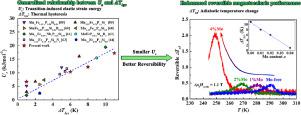Journal of Materials Science & Technology ( IF 11.2 ) Pub Date : 2021-09-08 , DOI: 10.1016/j.jmst.2021.05.087 Xuefei Miao 1 , Yong Gong 1 , Fengqi Zhang 2 , Yurong You 1 , Luana Caron 3, 4 , Fengjiao Qian 5 , Wenhui Guo 1 , Yujing Zhang 1 , Yuanyuan Gong 1 , Feng Xu 1 , Niels van Dijk 2 , Ekkes Brück 2

|
Magnetocaloric materials undergoing reversible phase transitions are highly desirable for magnetic refrigeration applications. (Mn,Fe)2(P,Si) alloys exhibit a giant magnetocaloric effect accompanied by a magnetoelastic transition, while the noticeable irreversibility causes drastic degradation of the magnetocaloric properties during consecutive cooling cycles. In the present work, we performed a comprehensive study on the magnetoelastic transition of the (Mn,Fe)2(P,Si) alloys by high-resolution transmission electron microscopy, in situ field- and temperature-dependent neutron powder diffraction as well as density functional theory calculations (DFT). We found a generalized relationship between the thermal hysteresis and the transition-induced elastic strain energy for the (Mn,Fe)2(P,Si) family. The thermal hysteresis was greatly reduced from 11 to 1 K by a mere 4 at.% substitution of Fe by Mo in the Mn1.15Fe0.80P0.45Si0.55 alloy. This reduction is found to be due to a strong reduction in the transition-induced elastic strain energy. The significantly enhanced reversibility of the magnetoelastic transition leads to a remarkable improvement of the reversible magnetocaloric properties, compared to the parent alloy. Based on the DFT calculations and the neutron diffraction experiments, we also elucidated the underlying mechanism of the tunable transition temperature for the (Mn,Fe)2(P,Si) family, which can essentially be attributed to the strong competition between the covalent bonding and the ferromagnetic exchange coupling. The present work provides not only a new strategy to improve the reversibility of a first-order magnetic transition but also essential insight into the electron-spin-lattice coupling in giant magnetocaloric materials.
中文翻译:

通过最小化转变引起的弹性应变能来增强 (Mn,Fe)2(P,Si) 合金中磁弹性转变的可逆性
经历可逆相变的磁热材料非常适合磁制冷应用。(Mn,Fe) 2 (P,Si) 合金表现出伴随着磁弹性转变的巨大磁热效应,而明显的不可逆性导致在连续冷却循环期间磁热性能急剧下降。在目前的工作中,我们通过高分辨率透射电子显微镜对 (Mn,Fe) 2 (P,Si) 合金的磁弹性转变进行了全面研究,原位场和温度相关的中子粉末衍射以及密度泛函理论计算 (DFT)。我们发现了 (Mn,Fe) 2 (P,Si) 族的热滞后和转变诱导的弹性应变能之间的广义关系。通过在 Mn 1.15 Fe 0.80 P 0.45 Si 0.55 中仅用 4 at.% 的 Fe 替换 Fe,热滞后从 11 K 大大降低到 1 K合金。发现这种减少是由于转变引起的弹性应变能的强烈减少。与母合金相比,磁弹性转变的显着增强的可逆性导致可逆磁热性能的显着改善。基于 DFT 计算和中子衍射实验,我们还阐明了 (Mn,Fe) 2的可调转变温度的潜在机制(P,Si) 族,这基本上可以归因于共价键合和铁磁交换耦合之间的强烈竞争。目前的工作不仅提供了一种提高一阶磁跃迁可逆性的新策略,而且还提供了对巨磁热材料中电子-自旋-晶格耦合的重要见解。











































 京公网安备 11010802027423号
京公网安备 11010802027423号